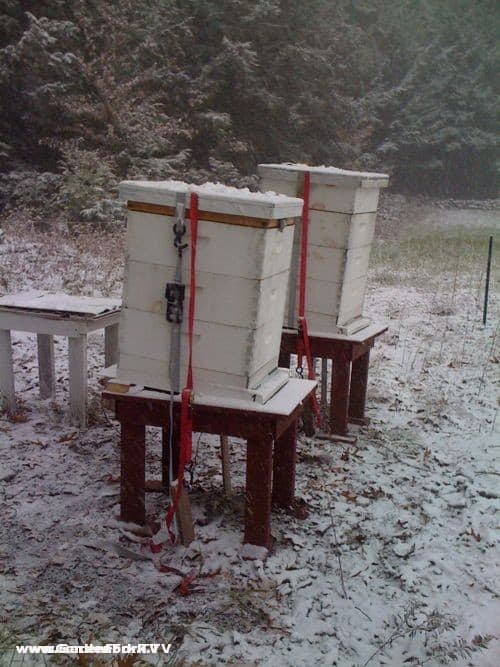Here’s how to overwinter your beehives & have the bees survive winter. We will do into the following steps that I take to get my beehives to survive winter:
Note: I have an updated post on winter prep here, but below is a good read as well.
- Feed bees 2:1 sugar syrup with essential oil mix throughout the fall
- Insulated Inner Covers
- Wrap Hives In Polystyrene
Sugar CakeDry Sugar Winter Feed see this post & videos for the how to- Hives tilted forward
- Metal mouse guards
- Hives strapped to ground.
I feed the honeybees sugar syrup all fall, i start just after we harvest honey. I have become a big fan of using zipper type food bags, learn more and see 2 videos here.
Winter is coming. Just before the October storm that dumped 20″ of snow here, I went out to our two beeyards and got the beehives ready for winter.
The biggest danger to beehives in winter , i think, is condensation. Humidity builds up inside a warm hive, hits the top of the hive, which is cold, and the water condenses into droplets that rain back down onto the bees. Many times this kills the hive.
There are a number of things you can do to reduce condensation in a beehive. Most important is to keep air circulating in the hive, don’t seal up the hive tight. You need air moving through the hive to remove the moisture. I believe everyone should use an inner cover with a notch, aka upper entrance, in the warm months. This allows air to flow through the hive .
In winter, I’ve been using insulated inner covers and sugarcakes with great success.
The insulated inner covers help reduce condensation, and provide space for the sugarcakes, watch the video and see insulated inner cover plans here. Since using the insulated inner covers, I have not had condensation problems.
 I used to use sugarcakes to provide emergency food and a great way to absorb excess moisture in the hive. But I now use the Mountain Camp Dry Sugar Feed method, and it works well. Video here.
I used to use sugarcakes to provide emergency food and a great way to absorb excess moisture in the hive. But I now use the Mountain Camp Dry Sugar Feed method, and it works well. Video here.

There is an ongoing disagreement on whether one should keep the sticky board inserted into the screened bottom board or not in winter. I think it depends on how cold it gets in your area. Around us, it gets below zero a few times each winter, and stays in the single digits at times, so I close the screened bottom board.


The second thing, and just as important, i think, is to tilt the hives. Pretty simple, but tilting the hive will allow any water that has condensed on the inside of the inner top cover of the hive to, by gravity, move toward the front of the hive, and hit the front wall. The water drops then drain out the front of the hive, away from the bees.
Tilt your hives forward by placing a piece of 2×4 scrap lumber under the back of the hive as shown in the picture.
I use metal mouse guards on our hives, the holes in the guard allow enough air to move through the hive when used with the insulated inner covers, I think.

New: I have tried various methods to insulate the hives, and this year I have used 2″ polystyrene. This isn’t the most elegant solution, but it seems to work. I tried various methods of cutting and affixing the insulation, but for this winter, just cutting them to the fit each side of the hive and strapping them together worked well. Its best if you have two people doing this.
Another important thing to do in areas with high winds in winter, is to strap your hives down to the ground to keep them from blowing over. We double strap our hives because of bears, one strap around the hive itself, another strap goes around the beehive and attaches to stakes hammered into the ground.

We used wooden stakes hammered into the ground for the straps, but they work loose with frost heaves and all. Here is a photo of GF viewer Doug’s hives, and he used a spiral metal stake, used for dog runs and camping, that wont pull out of the ground. great idea. i’ve seen these spiral stakes at the home improvement stores.

Read more of our beekeeping posts here and watch beekeeping videos here. Thx!

